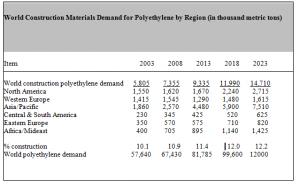December 2014, Vol. 241, No. 12
Features
Global Demand For Polyethylene To Reach 99.6 Million Tons In 2018

Global demand for polyethylene resins – HDPE, LLDPE and LDPE – will rise 4% per year to 99.6 million metric tons in 2018, valued at $164 billion. Gains will match overall world economic growth, fueled by an acceleration in consumer spending and manufacturing activity.
Polyethylene will continue to be the most widely used plastic resin in the world, benefiting from its versatility, easy processability, low cost and recyclability. The development of ethylene feedstocks from new sources, such as shale gas, coal and bio-based materials will also give polyethylene a price or sustainability advantage relative to other plastic resins.
Moreover, continually improving polymerization catalyst technologies will enhance the performance, customization and yield of polyethylene resins. HDPE is the most widely used of the three polyethylene resins, accounting for just under half of total demand in 2013. These and other trends are presented in World Polyethylene, a new study from The Freedonia Group, Inc., a Cleveland, OH-based market research firm.
Analyst Kent Furst notes, however, that further increases in polyethylene demand will be limited by a number of factors.
“Polyethylene is a highly commoditized and mature product, and large volume new applications are unlikely to emerge in the foreseeable future. Additionally, polyethylene (like all plastics) is perceived negatively by many environmentally minded consumers, and major polyethylene applications such as plastic bags have increasingly become subject to regulations and bans.”
The Asia/Pacific region will continue to be the largest and fastest growing polyethylene market through 2018, fueled by strong growth in China, which alone accounted for nearly one-quarter of global demand in 2013. India and Vietnam will also be among the world’s most rapidly expanding markets. However, advances in most emerging Asian countries will rise at a slower pace than during the 2008-2013 period. On the other hand, North America will see a significant improvement in polyethylene demand, while the markets in Western Europe and Japan will rebound from recent declines.
World polyethylene demand in construction markets is forecast to expand 5.1% per year to 12 million metric tons in 2018. Gains will be driven by a strong rebound in construction spending in North America and Western Europe from the declines of the 2008-2013 period. This recovery is particularly apparent in the United States, which is an intensive consumer of polyethylene in sewer and drainage pipe applications, and where the construction recovery will be the strongest.
Additionally, rising residential construction and infrastructure spending in the developing world will bolster polyethylene demand due to the need for both housing and basic infrastructure throughout the developing world, particularly in rapidly expanding urban areas.
The primary application for polyethylene in the construction market is pipe and conduit, where HDPE is the dominant resin, although LDPE can also be used. Demand for pipe and conduit is rising rapidly due to infrastructure projects related to potable water supplies, and sewer and drainage systems. In water-related applications, HDPE has a major advantage in that its smooth interior allows for high-flow rates.
In comparison with other pipe materials, such as cast iron and steel, HDPE pipe offers flexibility, durability, light weight, corrosion resistance and the ability to produce high-integrity joints. HDPE is also gaining share over polyvinyl chloride (PVC) pipe, which is often disfavored for environmental reasons.
In smaller diameter pipes, HDPE can be produced in long, continuous lengths, limiting the potential for leaks and reducing labor costs. Small-diameter HDPE pipe is most commonly used for gas distribution applications, which include the delivery of natural gas from local terminals into individual buildings. Polyethylene film also has numerous construction applications, such as use in the waterproofing of homes, as windbreaks, as a moisture barrier beneath poured concrete and as an exterior cover for weather-sensitive materials, such as wood.
World Construction Materials Demand for Polyethylene by Region

(World Polyethylene (published 10/2014, 491 pages) is available for sale from The Freedonia Group, Inc. For further details, visit www.freedoniagroup.com.)





Comments